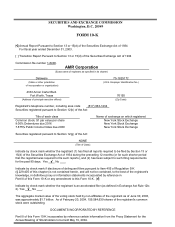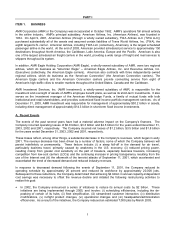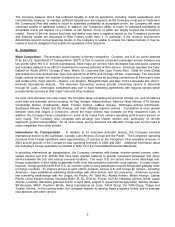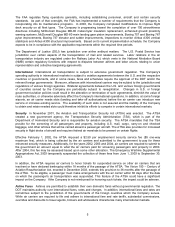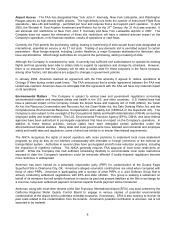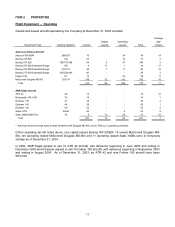American Airlines 2003 Annual Report Download - page 3
Download and view the complete annual report
Please find page 3 of the 2003 American Airlines annual report below. You can navigate through the pages in the report by either clicking on the pages listed below, or by using the keyword search tool below to find specific information within the annual report.
1
PART I
ITEM 1. BUSINESS
AMR Corporation (AMR or the Company) was incorporated in October 1982. AMR’s operations fall almost entirely
in the airline industry. AMR's principal subsidiary, American Airlines, Inc. (American Airlines), was founded in
1934. On April 9, 2001, American Airlines (through a wholly owned subsidiary, TWA Airlines LLC (TWA LLC))
purchased substantially all of the assets and assumed certain liabilities of Trans World Airlines, Inc. (TWA), the
eighth largest U.S. carrier. American Airlines, including TWA LLC (collectively, American), is the largest scheduled
passenger airline in the world. At the end of 2003, American provided scheduled jet service to approximately 150
destinations throughout North America, the Caribbean, Latin America, Europe and the Pacific. American is also
one of the largest scheduled air freight carriers in the world, providing a wide range of freight and mail services to
shippers throughout its system.
In addition, AMR Eagle Holding Corporation (AMR Eagle), a wholly-owned subsidiary of AMR, owns two regional
airlines, which do business as "American Eagle” -- American Eagle Airlines, Inc. and Executive Airlines, Inc.
(Executive) (collectively, the American Eagle carriers). American also contracts with three independently owned
regional airlines, which do business as the “American Connection” (the American Connection carriers). The
American Eagle carriers and the American Connection carriers provide connecting service from eight of
American's high-traffic cities to smaller markets throughout the United States, Canada and the Caribbean.
AMR Investment Services, Inc. (AMR Investment), a wholly-owned subsidiary of AMR, is responsible for the
investment and oversight of assets of AMR’s employee benefit plans, as well as its short-term investments. It also
serves as the investment manager of the American AAdvantage Funds, a family of mutual funds with both
institutional and retail shareholders, and provides customized fixed income portfolio management services. As of
December 31, 2003, AMR Investment was responsible for management of approximately $30.2 billion in assets,
including direct management of approximately $14.3 billion in short-term fixed income investments.
A. Recent Events
The events of the past several years have had a material adverse impact on the Company's finances. The
Company incurred operating losses of $0.8 billion, $3.3 billion and $2.5 billion for the years ended December 31,
2003, 2002 and 2001, respectively. The Company incurred net losses of $1.2 billion, $3.5 billion and $1.8 billion
for the years ended December 31, 2003, 2002 and 2001, respectively.
These losses reflect, among other things, a substantial decrease in the Company's revenues, which began in early
2001. The revenue decrease has been driven by a number of factors, some of which the Company believes will
persist indefinitely or permanently. These factors include: (i) a steep fall-off in the demand for air travel,
particularly business travel, primarily caused by weakness in the U.S. economy, (ii) reduced pricing power,
resulting mainly from greater cost sensitivity on the part of travelers, especially business travelers, increasing
competition from low-cost carriers (LCCs) and the continuing increase in pricing transparency resulting from the
use of the Internet and (iii) the aftermath of the terrorist attacks of September 11, 2001, which accelerated and
exacerbated the trend of decreased demand and reduced industry revenues.
In response to decreased demand following the events of September 11, 2001, the Company reduced its
operating schedule by approximately 20 percent and reduced its workforce by approximately 20,000 jobs.
Subsequent to these reductions, the Company determined that achieving $4 billion in annual capacity-independent
cost savings was necessary to offset the revenue decline and initiated the following restructuring activities to
realize this goal:
• In 2002, the Company announced a series of initiatives to reduce its annual costs by $2 billion. These
initiatives are being implemented through 2005, and involve: (i) scheduling efficiencies, including the de-
peaking of certain of its hubs, (ii) fleet simplification, (iii) streamlined customer interaction, (iv) distribution
modifications, (v) in-flight product changes, (vi) operational changes and (vii) headquarters/administration
efficiencies. As a result of the initiatives, the Company reduced an estimated 7,000 jobs by March 2003.


